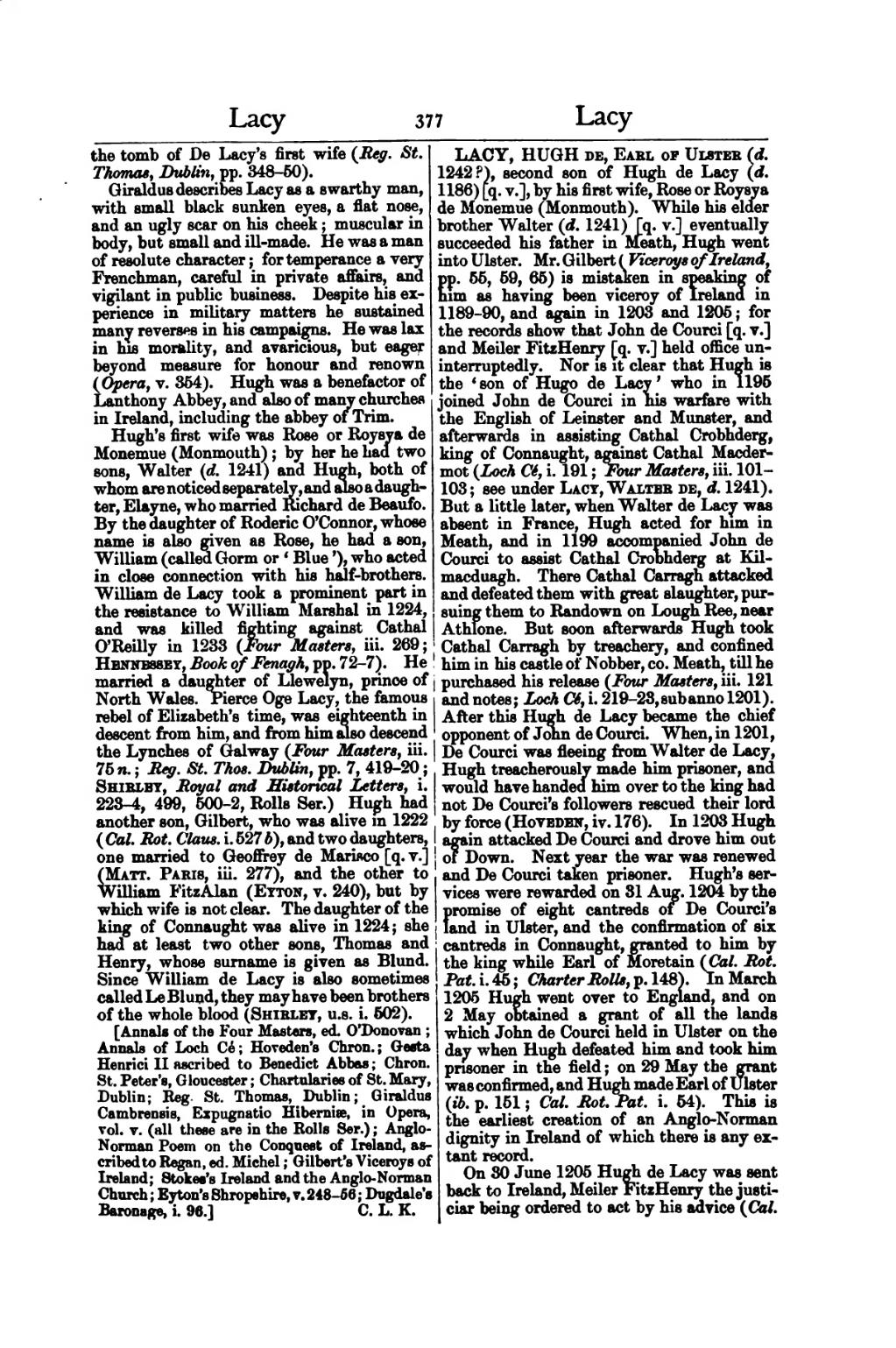the tomb of De Lacy's first wife (Reg. St. Thomas, Dublin, pp. 348–50).
Giraldus describes Lacy as a swarthy man, with small black sunken eyes, a flat nose, and an ugly scar on his cheek; muscular in body, but small and ill-made. He was a man of resolute character; for temperance a very Frenchman, careful in private affairs, and vigilant in public business. Despite his experience in military matters he sustained many reverses in his campaigns. He was lax in his morality, and avaricious, but eager beyond measure for honour and renown (Opera, v. 354). Hugh was a benefactor of Lanthony Abbey, and also of many churches in Ireland, including the abbey of Trim.
Hugh's first wife was Rose or Roysya de Monemue (Monmouth); by her he had two sons, Walter (d. 1241) and Hugh, both of whom are noticed separately, and also a daughter, Elayne, who married Richard de Beaufo. By the daughter of Roderic O'Connor, whose name is also given as Rose, he had a son, William (called Gorm or ‘Blue’), who acted in close connection with his half-brothers. William de Lacy took a prominent part in the resistance to William Marshal in 1224, and was killed fighting against Cathal O'Reilly in 1233 (Four Masters, iii. 269; Hennessey, Book of Fenagh, pp. 72–7). He married a daughter of Llewelyn, prince of North Wales. Pierce Oge Lacy, the famous rebel of Elizabeth's time, was eighteenth in descent from him, and from him also descend the Lynches of Galway (Four Masters, iii. 75 n.; Reg. St. Thos. Dublin, pp. 7, 419–20; Shirley, Royal and Historical Letters, i. 223–4, 499, 500–2, Rolls Ser.) Hugh had another son, Gilbert, who was alive in 1222 (Cal. Rot. Claus. i. 527 b), and two daughters, one married to Geoffrey de Marisco [q. v.] (Matt. Paris, iii. 277), and the other to William FitzAlan (Eyton, v. 240), but by which wife is not clear. The daughter of the king of Connaught was alive in 1224; she had at least two other sons, Thomas and Henry, whose surname is given as Blund. Since William de Lacy is also sometimes called Le Blund, they may have been brothers of the whole blood (Shirley, u.s. i. 502).
[Annals of the Four Masters, ed. O'Donovan; Annals of Loch Cé; Hoveden's Chron.; Gesta Henrici II ascribed to Benedict Abbas; Chron. St. Peter's, Gloucester; Chartularies of St. Mary, Dublin; Reg. St. Thomas, Dublin; Giraldus Cambrensis, Expugnatio Hiberniæ, in Opera, vol. v. (all these are in the Rolls Ser.); Anglo-Norman Poem on the Conquest of Ireland, ascribed to Regan, ed. Michel; Gilbert's Viceroys of Ireland; Stokes's Ireland and the Anglo-Norman Church; Eyton's Shropshire, v. 248–56; Dugdale's Baronage, i. 96.]
LACY, HUGH de, Earl of Ulster (d. 1242?), second son of Hugh de Lacy (d. 1186) [q. v.], by his first wife, Rose or Roysya de Monemue (Monmouth). While his elder brother Walter (d. 1241) [q. v.] eventually succeeded his father in Meath, Hugh went into Ulster. Mr. Gilbert (Viceroys of Ireland, pp. 55, 59, 65) is mistaken in speaking of him as having been viceroy of Ireland in 1189–90, and again in 1203 and 1205; for the records show that John de Courci [q. v.] and Meiler FitzHenry [q. v.] held office uninterruptedly. Nor is it clear that Hugh is the ‘son of Hugo de Lacy’ who in 1195 joined John de Courci in his warfare with the English of Leinster and Munster, and afterwards in assisting Cathal Crobhderg, king of Connaught, against Cathal Macdermot (Loch Cé, i. 191; Four Masters, iii. 101–103; see under Lacy, Walter de, (d. 1241)). But a little later, when Walter de Lacy was absent in France, Hugh acted for him in Meath, and in 1199 accompanied John de Courci to assist Cathal Crobhderg at Kilmacduagh. There Cathal Carragh attacked and defeated them with great slaughter, pursuing them to Randown on Lough Ree, near Athlone. But soon afterwards Hugh took Cathal Carragh by treachery, and confined him in his castle of Nobber, co. Meath, till he purchased his release (Four Masters, iii. 121 and notes; Loch Cé, i. 219–23, sub anno 1201). After this Hugh de Lacy became the chief opponent of John de Courci. When, in 1201, De Courci was fleeing from Walter de Lacy, Hugh treacherously made him prisoner, and would have handed him over to the king had not De Courci's followers rescued their lord by force (Hoveden, iv. 176). In 1203 Hugh again attacked De Courci and drove him out of Down. Next year the war was renewed and De Courci taken prisoner. Hugh's services were rewarded on 31 Aug. 1204 by the promise of eight cantreds of De Courci's land in Ulster, and the confirmation of six cantreds in Connaught, granted to him by the king while Earl of Moretain (Cal. Rot. Pat. i. 45; Charter Rolls, p. 148). In March 1205 Hugh went over to England, and on 2 May obtained a grant of all the lands which John de Courci held in Ulster on the day when Hugh defeated him and took him prisoner in the field; on 29 May the grant was confirmed, and Hugh made Earl of Ulster (ib. p. 151; Cal. Rot. Pat. i. 54). This is the earliest creation of an Anglo-Norman dignity in Ireland of which there is any extant record.
On 30 June 1205 Hugh de Lacy was sent back to Ireland, Meiler FitzHenry the justiciar being ordered to act by his advice (Cal.
